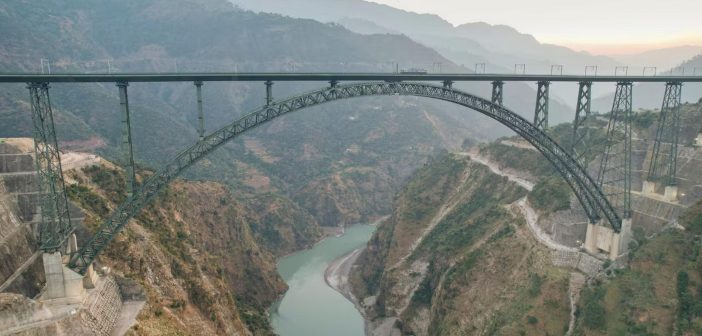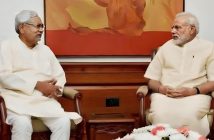Prime Minister Narendra Modi inaugurated the world’s tallest railway bridge over the Chenab River in Jammu and Kashmir, a monumental engineering feat. Standing 359 meters above the riverbed, the Chenab Bridge connects Kashmir to India’s rail network, promising faster travel, boosted tourism, and enhanced defence logistics. Amid tight security, Modi flagged off Vande Bharat trains, marking a new era for regional connectivity. This architectural marvel, part of the ₹43,780 crore USBRL project, symbolizes India’s resolve and vision. Local voices resonate with pride, envisioning economic growth and national unity.
On June 6, 2025, Prime Minister Narendra Modi inaugurated the Chenab Bridge, the world’s tallest railway arch bridge, in Jammu and Kashmir’s Reasi district. Standing 359 meters above the Chenab River, this engineering marvel dwarfs the Eiffel Tower and forms a vital part of the Udhampur-Srinagar-Baramulla Rail Link (USBRL). The bridge promises to transform connectivity, cutting travel time between Katra and Srinagar to just three hours via Vande Bharat trains. Amid cheers and tight security, Modi hailed it as a symbol of “New India’s” resolve. The ₹1,400 crore project, designed to withstand earthquakes and extreme weather, also enhances tourism and defence logistics. This historic event, marked by Modi’s first visit to J&K post-Operation Sindoor, underscores India’s ambitious infrastructure plans.
Key Details
- Who: Prime Minister Narendra Modi, J&K Chief Minister Omar Abdullah, Railway Minister Ashwini Vaishnaw, and Union Minister Jitendra Singh.
- What: Inauguration of the Chenab Bridge and two Vande Bharat Express trains.
- When: June 6, 2025, in Reasi district, Jammu and Kashmir.
- Where: Chenab Bridge, spanning the Chenab River between Bakkal and Kauri, and Katra railway station.
- Why: To enhance rail connectivity, boost tourism, and strengthen strategic and economic ties in J&K.
Background: A Feat of Engineering
The Chenab Bridge, world’s tallest arch railway bridge is a part of the ₹43,780 crore USBRL project, is a global engineering marvel. At 1,315 meters long, it towers 359 meters above the riverbed, surpassing Paris’ Eiffel Tower by 35 meters. Built-in a seismic Zone-V, it withstands earthquakes up to a magnitude of 8 and winds of 266 km/h. The bridge used 30,000 metric tons of steel and 66,000 cubic meters of concrete. Its foundation, S20, spans nearly one-third of a football field. Designed with the input of DRDO, it’s blast-resistant and vital for defence logistics. Construction, overseen by the Konkan Railway Corporation, involved Afcons Infrastructure, South Korea’s Ultra Construction, and VSL India, with design inputs from IIT Delhi and IIT Roorkee, as well as global firms such as WSP Group.
Key Events: A Grand Launch
Modi arrived at Udhampur Air Force station. He reached the bridge site by helicopter. He inspected the Chenab Bridge and a railway museum. Modi met engineers and workers. He launched the Anji Khad Bridge, India’s first cable-stayed rail bridge. Two Vande Bharat trains were flagged off. They connect Katra to Srinagar. The trains are equipped with silicone heating for cold weather. Regular service starts June 7, 2025. Modi announced ₹46,000 crore in projects. These include roads and a medical college. Security was tight after the Pahalgam attack.
Stakeholder Perspectives
Modi said, “This bridge shows New India’s resolve and pride.” He emphasized infrastructure for growth. Ashwini Vaishnaw, Railway Minister, stated, “Tourism and economy will grow fast.” A railway engineer told ANI, “This bridge is India’s strength in steel.” Resident Anil Sharma said, “It brings Kashmir closer to us.” Travel agent Rajan Sehgal added, “Tourists will flock to see this bridge.” Congress criticized Modi for ignoring past contributions to the project.
Strategic and Economic Impact
The bridge cuts Katra-Srinagar travel time from six to three hours. It boosts tourism, with the Ministry of Tourism planning promotions. Defence logistics improve, aiding troop movement in border areas. The USBRL’s 272 km, with 36 tunnels and 943 bridges, ensures all-weather connectivity. Local economies will thrive with better access to markets. The Shri Mata Vaishno Devi Institute of Medical Excellence, also launched, enhances healthcare. Roads built during construction now serve remote villages, easing access.
Conclusion
The Chenab Bridge is a triumph of engineering and vision. It connects Kashmir to India’s heart. The bridge drives tourism, trade, and security. Vande Bharat trains mark a new era. This milestone shapes a prosperous future for Jammu and Kashmir.
Explore how Chenab Bridge reshapes Jammu and Kashmir’s future.




